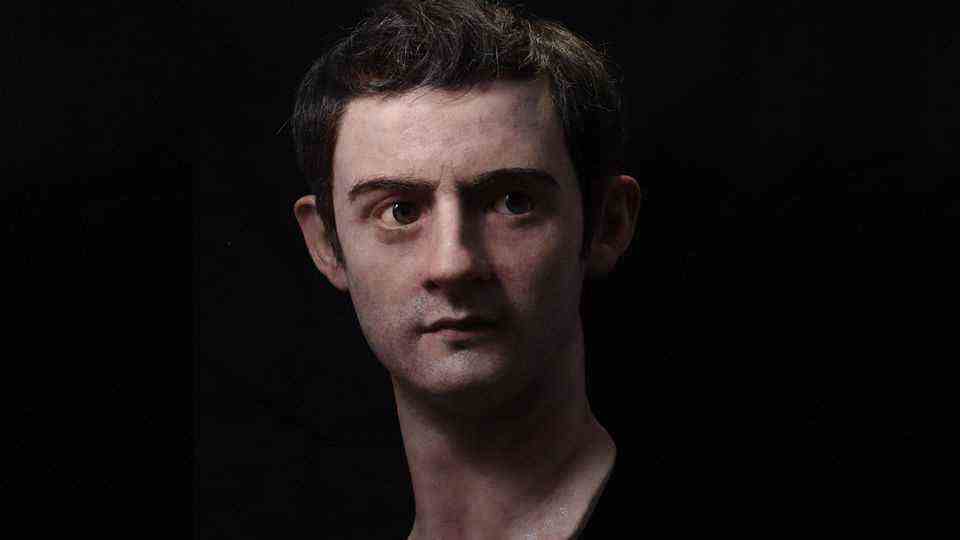Emperor
Caesar, Augustus, Caligula, Nero – this is what the powerful rulers of Rome really looked like
Caesar destroyed the Roman Republic, but failed to reconcile the opponents. He was murdered in Rome.
© Caesares de Romano Salva Ruano
We only know the Caesars from marble – immaculate and relieved. A sculptor created realistic faces for the Caesars, they are as alive as they are made of flesh and blood.
When we think of the famous Caesars of Rome, we remember their marble busts. Deprived and idealized, the rulers of Rome look more like gods than the people they really were. The exhibition “Caesars of Rome” brings some of the most famous rulers to life as if they were among us. For our time it is astonishing that the young sculptor Salva Ruano modeled the heads of Caesar, the young Octavian, Caligula and Nero and that no computer program was at work.
The basis of the reconstruction are the busts of the rulers. They are considered idealized, but also applicable, since the first busts were made while the men were still alive. In addition to the marble heads, the coarser images on coins and the sometimes detailed descriptions of contemporaries were used. The faces were made like a wax figure.
The man who smashed the republic
The most famous ruler is probably Gaius Julius Caesar, the founder of the Julian-Claudian dynasty. The man who destroyed the Republic in the Civil War and was killed by his opponents on the steps of the Capitol. In contrast to the Asterix comics, which incidentally were also based on the busts of Caesar, Gaius Julius Caesar is shown neither in a laurel wreath nor as a white-haired old man. Salva Ruano shows the power man Caesar in his forties, with graying hair but full of energy and resilience. A man who should not be underestimated and whom no one wanted to have as an enemy if he wanted to survive. What is particularly interesting about the work are the hyper-realistic signs of age; this is where the work differs most clearly from the flawless marble.
A youth before world power
Second in the round is the most powerful ruler of the dynasty. Caesar’s adopted son Octavian is depicted not as the ruling Augustus, but as a young man. In the aftermath of Caesar’s assassination, he assumed the role of successor and pursued the Republican party, which had defeated his adoptive father, in another civil war. The work shows him at the moment when hardly anyone believed the youth to win the bloody struggle and later rule. Most noticeable are its large, curious eyes. As Augustus, Octavian ruled for 45 years. He reconciled the warring parties and headed the empire in a heyday.
In Germany, however, Augustus is associated with the greatest catastrophe of his rule: the defeat of Varus in the Teutoburg Forest and the complete loss of three legions. The Bringer of Peace – according to the ruler’s own PR – laid the foundations for the empire. Augustus solved the problems that had ruined the republic, but the powerful and unscrupulous ruler was helpless to face the new problems that resulted from the dynastic principle. He could not prevent the central question of his successor’s power within the family from being decided by murder. In this way the most hopeful candidates were put out of the way.
His immediate successor, Tiberius, was still a capable steward and general, but he instituted a reign of terror and fear – although the accounts of his personal cruelty and sexual debauchery were probably exaggerated, if not invented.
Caligula – the depraved
In the environment of the old Tiberius on the island of Capri, Caligula was coined and chosen as his successor. After suspending the high treason trials, he had real and supposed opponents tortured and killed again shortly afterwards. His wastefulness ruined the state finances – his sexual excesses repelled the Romans. Especially since he is said to have raped women from high-ranking families. Eventually he was killed by his own bodyguard.
Inglorious end of a dynasty
The following rulers of the family were visibly more incompetent, but at the same time more cruel and self-centered. The term Caesar’s madness goes back to her – the loss of all inhibitions through limitless power. The last ruler of the dynasty comes from their ranks: Nero. Across the female line, he was a great-great-grandson of the Emperor Augustus. Today he is best known for his Christian-inspired novels and the Hollywood films based on them. He was – wrongly – held responsible for the fire in Rome in 64 and rightly for the first persecution of Christians. Cruelty and debauchery led him to lose control of the empire.
The legions rebelled against the unworthy emperor and the Praetorian Guard stationed in Rome, on which the tyranny of the Caesars was based, left him. In the end only four faithful people accompanied the helpless emperor, who delayed suicide as long as possible. Only at the last moment, when you could already hear the rulers’ horses, did he kill himself with the help of his secretary.
Source: Caesares de Romano
Also read:
– Villa of the Praetorian Guard found near the construction of the underground – that’s how luxurious the ancient Romans lived
– Greek Fire: How a Refugee Invented Napalm of Antiquity
– Evaporating blood and exploding skulls – that’s how cruelly the victims of Vesuvius died
– Skulls and love spells – a magical tool discovered by a sorceress from Pompeii



